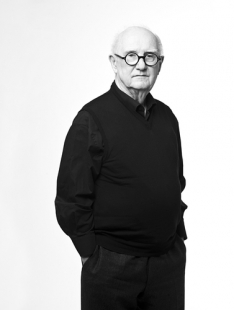
To the death of Friedrich Achleitner
Last Wednesday, the Austrian cultural scene lost a significant figure who dedicated his entire life to systematically exploring modern architecture. Friedrich Achleitner belonged to the post-war generation of graduates from the Vienna Academy of Fine Arts, who lacked the necessary knowledge of modern history, prompting Achleitner to independently compile the history of Austrian architecture in the mid-1960s. The result of his forty-five years of consistent work is the four-volume work "Austrian Architecture in the 20th Century." Achleitner began traveling west from one Austrian city to another, documenting individual buildings solely with the help of a camera and his trained eye. Ultimately, a comprehensive archive was created, consisting of over 25,000 index cards, 66,000 negatives, 38,000 slides, and 1,000 books, which the city of Vienna purchased on the occasion of Achleitner's seventieth birthday and transferred to the AzW for management, where it is now available to all researchers.
Friedrich Achleitner was born into a miller's family in a small village in Upper Austria. After the war and completing high school, he went to study architecture in Vienna at the Academy of Fine Arts under Clemens Holzmeister, graduating from his master's class in 1953. He subsequently collaborated with Johann Georg Gsteu on projects for sacred buildings. In 1958, he decided to leave the architectural profession and fully dedicated himself to writing. In the 1960s, he regularly contributed critical articles to the newspaper Die Presse. Until the early 1980s, he taught art history at the Vienna Academy, and later, until his retirement, he led courses in art history and architectural criticism at the University of Applied Arts, which awarded him an honorary ring in 2007. For the majority of his life (1965-2010), Achleitner devoted himself to compiling the publication "Austrian Architecture in the 20th Century." He passed away on March 27, 2019, in Vienna at the age of 88. Until his last moments, he was very active in literature. Occasionally, he would take a break from managing the extensive architectural database to engage in a more relaxed literary format, allowing him to play with words and sentences, which Czech readers can explore in the translation of the book Stories Before Sleep.
More information >
Friedrich Achleitner was born into a miller's family in a small village in Upper Austria. After the war and completing high school, he went to study architecture in Vienna at the Academy of Fine Arts under Clemens Holzmeister, graduating from his master's class in 1953. He subsequently collaborated with Johann Georg Gsteu on projects for sacred buildings. In 1958, he decided to leave the architectural profession and fully dedicated himself to writing. In the 1960s, he regularly contributed critical articles to the newspaper Die Presse. Until the early 1980s, he taught art history at the Vienna Academy, and later, until his retirement, he led courses in art history and architectural criticism at the University of Applied Arts, which awarded him an honorary ring in 2007. For the majority of his life (1965-2010), Achleitner devoted himself to compiling the publication "Austrian Architecture in the 20th Century." He passed away on March 27, 2019, in Vienna at the age of 88. Until his last moments, he was very active in literature. Occasionally, he would take a break from managing the extensive architectural database to engage in a more relaxed literary format, allowing him to play with words and sentences, which Czech readers can explore in the translation of the book Stories Before Sleep.
More information >
The English translation is powered by AI tool. Switch to Czech to view the original text source.

0 comments
add comment
Related articles
0
08.08.2023 | To the death of Jean-Louise Cohen
0
16.12.2021 | To the death of Günther Feuerstein
0
01.06.2021 | On the death of Terence Riley
0
21.05.2020 | To the death of Dietmar Steiner
0
22.03.2019 | To the death of Marcel Meili
0
20.06.2012 | <h1>About the death of Günther Domenig</h1>
1
15.04.2012 | To the death of Karljosef Schattner
0
17.07.2010 | To the death of Günter Behnisch












